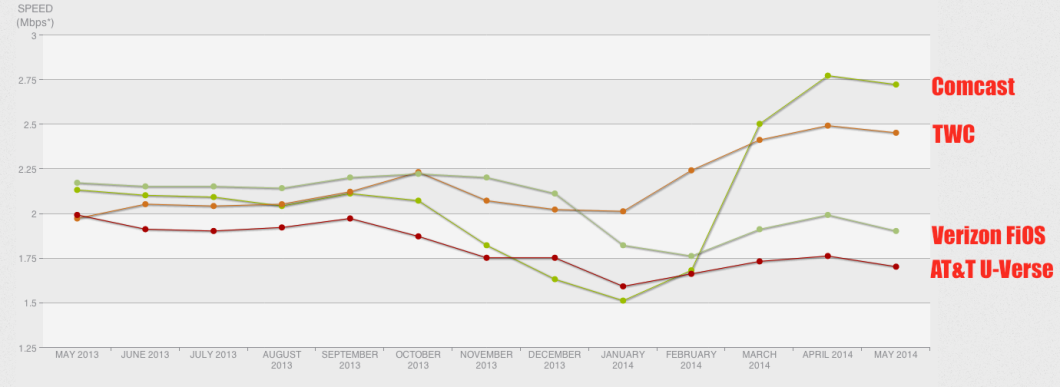Netflix Speeds On Verizon Do Not Improve Even After Agreeing To Pay Up
 When Netflix agreed to pay Comcast earlier this year for better access to the Comcast network, the streaming video service’s downstream speeds bounced back almost instantaneously and are now faster than they were a year ago. Netflix and Verizon announced a similar deal in late April, but the latest data shows no signs of improvement just yet.
When Netflix agreed to pay Comcast earlier this year for better access to the Comcast network, the streaming video service’s downstream speeds bounced back almost instantaneously and are now faster than they were a year ago. Netflix and Verizon announced a similar deal in late April, but the latest data shows no signs of improvement just yet.
Netflix has released its Speed Index data for May, the first month following its accord with Verizon FiOS, whose downstream speeds bottomed out in February after months of quickly declining performance.
The slowdown was due to Verizon’s unwillingness to upgrade its connections to the bandwidth providers that carry Netflix data from its servers to the ISPs, who then do the so-called “last mile” delivery to the end user. As those peering points became congested, a data bottleneck was created.
Paid-peering arrangements, like the one Comcast and Netflix announced in February, are intended to get around these bottlenecks by giving the content company more direct access to an ISP’s network.
In April, Netflix and Verizon announced that a deal had been made, but the data from May shows a downturn in speeds after two months of moderate improvements.
There is no explanation for the reversal of direction in FiOS data speeds, but the lack of improvement probably explains the recent battle of the buffering screens between Netflix and Verizon.
Last week, Verizon customers — and customers of other ISPs with slow connections — began seeing on-screen messages reading things like “The Verizon network is crowded right now,” while the video buffered.
Verizon slapped Netflix with a cease-and-desist letter regarding these messages, saying that Netflix provided no evidence that the slowdown was due to ISP congestion and not other factors that could affect the video quality.
Netflix says the messages were part of its campaign to be more transparent.
“As part of this transparency campaign, we started a small scale test in early May that lets consumers know, while they’re watching Netflix, that their experience is degraded due to a lack of capacity into their broadband provider’s network,” writes the company on its official blog. “We are testing this across the U.S. wherever there is significant and persistent network congestion This test is scheduled to end on June 16. We will evaluate rolling it out more broadly.”
Here’s how the other major ISPs stack up in the latest speed ratings:
Want more consumer news? Visit our parent organization, Consumer Reports, for the latest on scams, recalls, and other consumer issues.


